As I have reached ARG’s arrival in East Africa in July 1916, this seems to be a good moment to turn my attention to ARG’s first cousin David Gill, pictured far right in the above row of photos and as a boy in my last post and below.
David Gill was the only son of ARG’s uncle 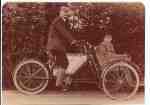 Albert Augustus Gill (AAG or “Uncle Bertie”), who was chief engineer at the Chelsea Water Company. His brother, ARG’s father, George Henry Gill (GHG) was company secretary.
Albert Augustus Gill (AAG or “Uncle Bertie”), who was chief engineer at the Chelsea Water Company. His brother, ARG’s father, George Henry Gill (GHG) was company secretary.
 David Gill was three years older than ARG and considering their fathers worked together, they must have seen a lot of each other as boys. I have obtained a copy of David’s file or service record from the National Archives. He joined the Royal Naval Air Service (RNAS) on 21 May 1915. Just before ARG was wounded at Ypres. David’s previous occupation is recorded as Electrical and Mechanical Engineer and it says he had been in the Officer Training Corps between 1904 to 1906, so presumably at school although the name of his school or any subsequent college is not given.
David Gill was three years older than ARG and considering their fathers worked together, they must have seen a lot of each other as boys. I have obtained a copy of David’s file or service record from the National Archives. He joined the Royal Naval Air Service (RNAS) on 21 May 1915. Just before ARG was wounded at Ypres. David’s previous occupation is recorded as Electrical and Mechanical Engineer and it says he had been in the Officer Training Corps between 1904 to 1906, so presumably at school although the name of his school or any subsequent college is not given.
David was pictured in Flight magazine June 1915 in No.3 Kite Balloon Section.
His service file records his promotion from Flight Sub-Lieutenant to Acting Flight Lieutenant on 29 December 1915 and his location seems to be Roehampton. On the same day his file records that he was promoted to Command of No.1 Kite Balloon Section.
No.1 Kite Balloon Section was an interesting unit of the RNAS providing observation for naval gun bombardments from a hot air balloon tethered on a fixed line to a ship. There were a number of these sections but No.1 Kite Balloon Section was aboard HMS Manica which had been operating in 1915 at Gallipoli in the Dardanelles, with great success. Useful background on HMS Manica and the No. 1 Kite Balloon Section, particularly the operations at Gallipoli can be found here, here and here. There is also a series of paintings and drawings done by the official artist Herbert Hillier aboard the HMS Manica during the Dardanelles campaign in the IWM on-line archive
I also found the following photographs in the album of ARG’s older brother Theo (George Theodore Gill – GTG), which suggest that David served at Gallipoli. However, there is no indication from his service file that he was transferred to No.1KBS before 29 December 1915, by which time the historical references record that HMS Manica was back in Britain to be refitted, ready for service in British East Africa (‘The Manica continued to lend ‘highly valuable service’ until mid-September, when she returned home for a refit by Cammell, Laird & Company‘) . Certainly the photographs look more like Africa to me than my image of Gallipoli. It may be that GTG was mistaken as I believe the photo album was compiled many years later possibly in the 1940s.
Click on the images to enlarge:
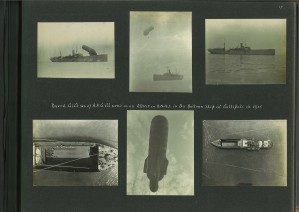
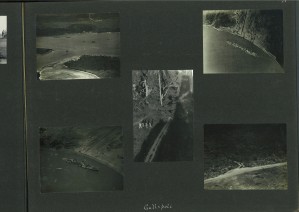
HMS Manica left Birkenhead on 10 March 1916 bound for East Africa and in addition to the Kite Balloon, they carried a seaplane which may be the subject of one of the un-marked photos in GTG’s album above. David’s service file records that he was ‘mentioned in dispatches by C. in C., Cape for high state of efficiency of his K.B. section & for good work in connection with capture of Bagamoyo by naval force on 15th August 1916’. A detailed account of the operations can be read here. Could the above photos from GTG’s album actually be of the RNAS in East Africa. Perhaps the photo on the top left of page 23 could be Tanga, Pangani or Bagamoyo? And could the sunken ship or ships pictured on page 23 be the Königsberg? [I think so. Look at this photo of the sunken Königsberg in the IWM collection]. The HMS Manica / No.1 KBS were not involved in the sinking of the Königsberg which occurred in July 1915 before they arrived in East Africa, but they were in the area in January 1917 as this account recalls. It’s not clear to me whether these are two photos of the same ship at different stages of its sinking or photos of two different ships. Further research might possibly reveal some likely candidates in the East Africa campaign that my help identify the location of the photos.
“While the flagship was lying off Bagamoyo, Admiral Charlton conceived the idea that he would like to make an ascent in the kite-balloon. It was fortunate that the sea was fairly calm, for I have heard of an occasion when an admiral went up in a kite-balloon, and, on descending again to his quarterdeck, was obliged to beat a precipitate retreat into his cabin. It is a curious fact that the motion of a ship, when communicated to the kite-balloon she is towing, becomes accentuated to such a degree that only an extra hardy mariner can hope to escape the effects of it. Admiral Charlton, however, was quite pleased with his experience, and later on he made a signal to the Manica.
“I am very much pleased with the efficiency of the Kite-Balloon Section, and the smart handling of the balloon. I wish to assure them that they are doing good and useful work.”
The tribute was much appreciated, for it is often the misfortune of those who labour with a new device to receive more criticism than encouragement. That it was also well deserved I hope that this record may afford ample evidence.
The best tribute, however, to the efficiency of the kite-balloon, and to the accuracy of its control over gunfire, has been paid by the enemy himself, both in East Africa and at Gallipoli. If the Manica came within range of the German guns with her kite-balloon down, they invariably opened fire, but, if the kite-balloon was up, the Germans in East Africa, like the Turks at Gallipoli, preserved a dignified silence. Experience had taught them wisdom.”
‘The Navy Everywhere’ by Conrad Gato, 1919 – Chapter XII, H.M.S. “MANICA” in East Africa
Probably as a result of his experience of the seaplane on HMS Manica, David put in an application to train as a seaplane pilot in May 1917 but he was turned down “on account of Fleet requirements of KB pilots’ which must have been rather a disappointment. His service file then records his ‘Returning to England 3.5.17′. David and ARG would have been in East Africa together between July 1916 and May 1917 but there is no record of any correspondence or meeting, which seems highly unlikely.
On return to England, David was attached to “Air Dept. N. 6 Section(A), Roehampton’ on 16 July 1917. I cannot find any information on this unit and what it did, but assume that if he was not released from KB duty on account of the requirements of the service for KB pilots, he may have been involved in training KB recruits.
On 9 November 1917 he was promoted to Acting Flight Commander and on 31 December 1917 was promoted to full Flight Commander. His promotion appearing in Flight Magazine in the King’s New Year Honours List in January 1918.
On 2 March 1918 it recorded that ‘Flt. Surgeon, Roehampton reports sick from 9/2/18 to 27/2/18 Malaria’ which seems to be the standard price that was paid for service in East Africa. Finally, on 16 May 1918 it seems David was granted his longstanding desire to train as a pilot and was posted to ‘Aircraft Establishment, S. Farnborough’.
I assume that David continued to train as a pilot for the duration of the war, which must have been good times for him. Unfortunately I understand that David succumbed to Influenza in the great epidemic of winter 1918/19. But I cannot find any record to confirm the date and cause of his death.
His medals were kept by ARG and I have them in the family collection. The spray of oak leaves on the Victory Medal for being Mentioned in Dispatches. It seems they were mounted onto blue card and then removed at some point. But when and why is unknown.

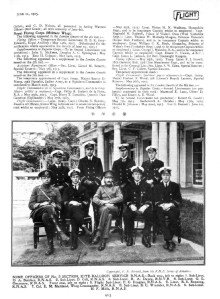


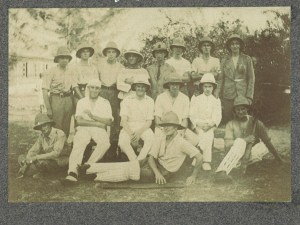
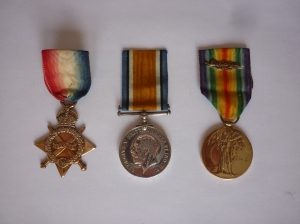
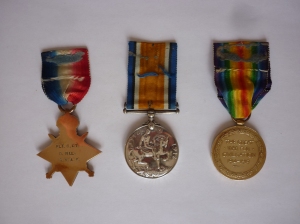
The pics in the 2nd album are E Africa. I have similar aerial photos of Konigsberg and the landscape. These had belonged to my g-pa then S-Lt John Edward Loveluck, the 1st officer (mate) of Manica. He, like the other RNR officers, was also at Gallipoli, which must have come as a big shock after returning in Manica from Oz in March 1915! I have photos of some of the docs re Manica at Kew & one report has a D Gill as observer in July 1916. I have a large photo of the Manica crew, which I think was at Gallipoli & another without the naval officers, which may be E Africa. Also several pics of the naval officers, nurses etc. Also some of HMS Waterwitch at Salonika,in 1916 & Constantinople in 1918-19 & copy of one at Gallipoli (google KSY Waterwitch). JEL was made master of Waterwitch from Jan 1918 when Lt Philip Bisson was killed when Louvain was torpedoed. Waterwitch is the only usable RN survivor of Gallipoli and is hired in Turkey for holidays & special events at Istanbul or Fethiye in the summer. I spent 5 days on her in 2007.
John Dixon in Chesterfield England
John, Many thanks for your comment. Would you by chance be able to identify any of the persons in the group shot: https://gillww1.files.wordpress.com/2012/04/gtg-photo-album-p-21-extract-3.jpg?
Kind regards, David